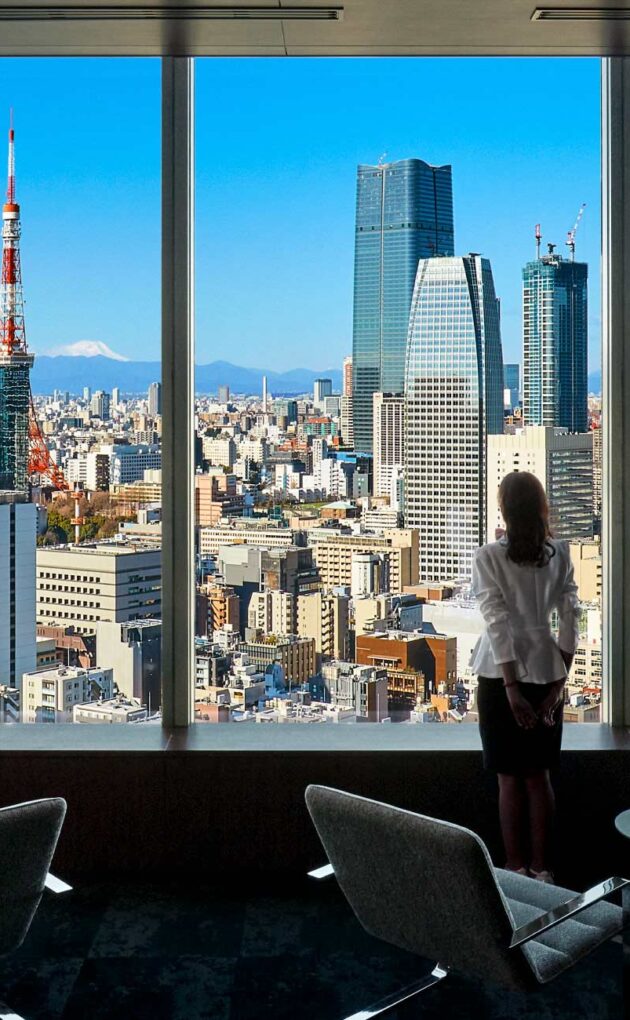Close


Above: Artworks by Nozomi Tanaka
The “Artist Rooms,” in which each guest room is a work of art, has become a symbol of Park Hotel Tokyo and have been favorably received by our guests. Following the 31st-floor, where all guest rooms are Artist Rooms, the 34th-floor guest rooms are scheduled to be transformed into artist rooms. In August 2023, the creation of the 11th Artist Room on the 34th floor began.
Creator: Nozomi Tanaka, Artist
Starting Date of Creation: August 14, 2023
Place of Creation: Room 3420, 34th Floor, Park Hotel Tokyo
Comment from artist Nozomi Tanaka
It is a pun on the term 48 browns and 100 greys (Shiju haccha hyaku Nezu means a lot of browns and greys), colors that arose among the common people in the late Edo period (1603-1868). Forty-eight and one hundred are not actual numbers, but forty-eight was a lucky number for many in ancient Japan. During the Edo period, the ongoing Sumptuary Laws specified the types of fabrics and dyed colors that samurai and townspeople could use. In particular, it was strictly forbidden for townspeople to wear kimonos made of silk, cotton, or linen and to dye them in gaudy colors; only brown and gray colors were allowed. In response to the shogunate’s Sumptuary Laws, which forbade the common people to be extravagant, people enjoyed various variations on the sober tones of brown, black, and gray, giving each color the name of a famous Kabuki actor or the wind, the moon, or landscapes. Within the permitted color range, new colors with subtle color differences emerged one after the other, such as rokocha, danjurocha, umenezu, and hatobanezumi. This pursuit of “different” and “stylish” kimonos, even in subdued tones, reflects the Japanese aesthetic sensibility.
Furthermore, the prohibition of extravagance and the control of culture imposed restrictions on kabuki and yose, which were popular pastimes for the common people at the time. Ukiyo-e was also subject to the luxury ban, and it was forbidden to paint shunga (erotic drawings and prints), paintings of kabuki actors, prostitutes, geishas, and other beauties. However, Edo period ukiyo-e artists continued to produce works while circumventing the ban and ironically expressing their feelings toward the shogunate’s control of the art world. (Examples: Kuniyoshi Utagawa’s “Picture of the Demon at the Mansion of Minamoto no Yorimitsu”; Utamaro Kitagawa’s “Famous Beauties from Six Houses: Tatsuharu of the Tsuruya House”; Yoshitsuya Utagawa’s “Neko no Sekai”; Kuniyoshi Utagawa’s “One-hundred Faces of Cats”; Toyokuni Utagawa’s “Kudo Saemon Suketsune”; Tada Fujikawa’s “Monster – Dressing Up”; Kuniyoshi Utagawa’s “Storehouse of Treasured Goods, Scribblings on the Wall”; Kuniyoshi Utagawa’s “Turtle Fun: Wonderful, Wonderful” etc.)
In these painters and common people of Edo, who found enjoyment and rebellion against the shogunate in a way that was not overt, I feel a spirit of Japanese aesthetics and inspiration common to contemporary art. Therefore, I would like to fill the walls of the room with homages to motifs painted by Edo-era artists (using rabbits as a motif), as well as scenes with rabbits inspired by the names of the 48 browns and 100 greys, in an attempt to create an expression that arises from the relationship of the culture and history of Edo, the root of Tokyo.
Born in Sendai City, Miyagi Prefecture, 1989. 2017 Completed the Doctoral Program in Art and Design, Tohoku University of Art & Design. She is an artist who expresses through painting based on the results of numerous studies and fieldwork on the climate and folklore of the Tohoku region. Like the Rakuchu-Rakugai-zu Folding Screen, many of Tanaka’s paintings start by examining the details in order to decipher the meaning of the larger whole. Tanaka’s works may seem to go against current trends, especially in today’s world, where the impression of an instantaneous image, especially on the Internet, determines the success or failure of an artwork. However, once one turns one’s attention to the details, even if one does not understand the meaning of each of the depicted representations, there is a pleasure in viewing Tanaka’s paintings as if one were unraveling a picture scroll, little by little, from the details to the whole, repeatedly discovering and being surprised. From the solo exhibition to the contemporary, from the local to the global, there is an accumulation of meanings behind the paintings in front of our eyes as an allegory that we must decipher from a contemporary perspective, and the adventure in Tanaka’s works, which has just begun, gives us immeasurable expectations.
Solo Exhibitions
-2023 N.E..blood21 Nozomi Tanaka solo Exhibition
-2022 Gift from Mountain, Art Front Gallery / Tokyo
-2017 A place and Sign, Art Front Gallery / Tokyo
-2015 Shiotsuchi, Yokohama Museum of Art, Kanagawa
Interviews during the creation of the Artist Room and coverage of other existing Artist Rooms, are welcome. Please feel free to contact us.